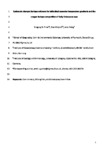Carbonate clumped isotope evidence for latitudinal seawater temperature gradients and the oxygen isotope composition of Early Cretaceous seas
| dc.contributor.author | Watanabe, Sayaka | |
| dc.contributor.author | Bajnai, D | |
| dc.contributor.author | Fiebig, J | |
| dc.date.accessioned | 2020-06-04T14:22:53Z | |
| dc.date.available | 2020-06-04T14:22:53Z | |
| dc.date.issued | 2020-08-15 | |
| dc.identifier.issn | 0031-0182 | |
| dc.identifier.issn | 1872-616X | |
| dc.identifier.other | 109777 | |
| dc.identifier.uri | http://hdl.handle.net/10026.1/15733 | |
| dc.description.abstract |
In this study, we investigated Early Cretaceous (Valanginian, ca. 135 million years ago) climate from subtropical to boreal palaeolatitudes. Combined carbonate clumped isotope and oxygen isotope data derived from sub-arctic, boreal, and sub-tropical fossil belemnite rostra (Mollusca: Cephalopoda) provide new palaeotemperature estimates as well as a constraint on the oxygen isotope composition of seawater. Our belemnite data reveal balmy high-latitude marine temperatures (ca. 22 °C) and warm sub-tropical temperatures (ca. 31 °C). Supplementing our clumped isotope-based temperature estimates with published TEX86 data results in a conservative reconstruction of a latitudinal temperature gradient that is reduced compared to modern conditions. We find that modelling efforts are close to reproducing tropical temperatures when high pCO2 levels are considered. Warm polar temperatures imply, however, that data-model discrepancies remain. Early Cretaceous seawater oxygen isotope values show a modern profile and are much more positive (up to 1.5‰ SMOW) than typically assumed. Based on our findings, if the positive Cretaceous seawater δ18O values are not considered, carbonate δ18O thermometry would underestimate temperatures, most acute at middle and tropical latitudes. | |
| dc.format.extent | 109777-109777 | |
| dc.language | en | |
| dc.language.iso | en | |
| dc.publisher | Elsevier BV | |
| dc.subject | Thermometry | |
| dc.subject | Valanginian | |
| dc.subject | Stable isotopes | |
| dc.subject | Belemnites | |
| dc.title | Carbonate clumped isotope evidence for latitudinal seawater temperature gradients and the oxygen isotope composition of Early Cretaceous seas | |
| dc.type | journal-article | |
| dc.type | Journal Article | |
| plymouth.author-url | https://www.webofscience.com/api/gateway?GWVersion=2&SrcApp=PARTNER_APP&SrcAuth=LinksAMR&KeyUT=WOS:000538140400011&DestLinkType=FullRecord&DestApp=ALL_WOS&UsrCustomerID=11bb513d99f797142bcfeffcc58ea008 | |
| plymouth.volume | 552 | |
| plymouth.publication-status | Published | |
| plymouth.journal | Palaeogeography, Palaeoclimatology, Palaeoecology | |
| dc.identifier.doi | 10.1016/j.palaeo.2020.109777 | |
| plymouth.organisational-group | /Plymouth | |
| plymouth.organisational-group | /Plymouth/Faculty of Science and Engineering | |
| plymouth.organisational-group | /Plymouth/Faculty of Science and Engineering/School of Geography, Earth and Environmental Sciences | |
| plymouth.organisational-group | /Plymouth/REF 2021 Researchers by UoA | |
| plymouth.organisational-group | /Plymouth/REF 2021 Researchers by UoA/UoA07 Earth Systems and Environmental Sciences | |
| plymouth.organisational-group | /Plymouth/Research Groups | |
| plymouth.organisational-group | /Plymouth/Research Groups/Marine Institute | |
| plymouth.organisational-group | /Plymouth/Users by role | |
| plymouth.organisational-group | /Plymouth/Users by role/Academics | |
| plymouth.organisational-group | /Plymouth/Users by role/Researchers in ResearchFish submission | |
| dcterms.dateAccepted | 2020-04-23 | |
| dc.rights.embargodate | 2021-4-27 | |
| dc.identifier.eissn | 1872-616X | |
| dc.rights.embargoperiod | Not known | |
| rioxxterms.versionofrecord | 10.1016/j.palaeo.2020.109777 | |
| rioxxterms.licenseref.uri | http://www.rioxx.net/licenses/all-rights-reserved | |
| rioxxterms.licenseref.startdate | 2020-08-15 | |
| rioxxterms.type | Journal Article/Review | |
| plymouth.funder | Carbonate clumped-isotopic constraints on marine temperatures during the Cretaceous::NERC |


